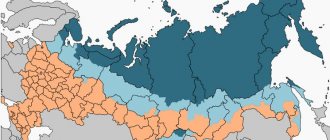Northern allowances and the regional coefficient serve to cover the increased material and physiological costs of citizens living and performing work in the North. When is the regional coefficient paid? How to determine its value? Find out from the article about its size and calculation.
Also see:
- Northern surcharge: what is it and how is it calculated
- How to find out the size of the northern surcharge: calculation examples
Legislative basis for the application of the regional coefficient
increased wages to employees employed in regions with difficult climatic conditions (Part 2 of Article 146 of the Labor Code of the Russian Federation). At the same time, the state establishes the minimum amount of additional payments to those working in such territories (Article 148 of the Labor Code of the Russian Federation).
In order to provide citizens with increased payments in regions with extreme natural environments, a regional coefficient and a northern salary supplement are used (Article 315 of the Labor Code of the Russian Federation).
According to Art. 316 of the Labor Code of the Russian Federation and Art. 10 of the Law of the Russian Federation of February 19, 1993 No. 4520-1, the size of the regional coefficient and the mechanism for its application are developed and approved by government bodies of the Russian Federation. In addition, these articles secure the right of regional authorities to establish, at the expense of local budgets, its increased value compared to the level approved centrally.
In the absence of a modern regulatory framework, legislative acts adopted back in the days of the USSR are used. But provided that they do not contradict the norms of the Labor Code of the Russian Federation (Article 423 of the Code).
As a result, the size of regional coefficients is currently regulated by a number of documents:
- Resolution of the State Committee for Labor of the USSR, All-Union Central Council of Trade Unions dated 09/04/1964 No. 380/P-18 - regarding coefficients for non-production industries;
- various resolutions of the State Committee for Labor of the USSR, the Secretariat of the All-Union Central Council of Trade Unions - for certain sectors of industry, agriculture and transport;
- resolutions of the Government of the Russian Federation - regarding the establishment of regional coefficients in certain territories;
- resolutions of regional authorities - approving an increased size of the regional coefficient in certain areas.
KEEP IN MIND!
currently no .
Commercial business entities are given the right, at their own expense, to establish in a collective agreement/local acts on remuneration a higher level of coefficient compared to the legally approved level (Article 135 of the Labor Code of the Russian Federation and letter of the Ministry of Labor dated November 26, 2012 No. 11-4/660). However, in any case it cannot be lower than the size specified in regulations.
The list of currently used regional coefficients is given in the tables below.
TABLE OF PARADISE. RATIOS FOR MANUFACTURING INDUSTRIES
TABLE OF PARADISE. RATIO FOR NON -PRODUCTION INDUSTRIES
In addition to the Far North, Siberia and the Far East, the regional coefficient has been established for some arid, high-mountain and desert territories of the Russian Federation.
TABLE OF PARADISE. COEFFICIENTS FOR SPECIAL TERRITORIES
Where which RCs operate?
We have collected the RKs for the regions in which they are installed in one table. Please note the asterisk (*): it means that the coefficient applies to certain categories of employees or in certain industries, which are specified in local laws and regulations of the Soviet period. Check with your local labor inspectorate for details.
All Republic of Kazakhstan by region and district (regions from A to K)
| Region and districts | RK |
| Altai | 1,4 |
| Altai Territory: Aleysky, Baevsky, Blagoveshchensky, Burlinsky, Volchikhinsky, Egoryevsky, Zavyalovsky, Klyuchevsky, Kulundinsky, Mamontovsky, Mikhailovsky, German, Novichikhinsky, Pankrushikhinsky, Pospelikhinsky, Rodinsky, Romanovsky, Rubtsovsky, Slavgorodsky, Suetsky, Tabunsky, Uglovsky, Khabarsky, Shipunovsky districts, Aleysk, Slavgorod, Yarovoye | 1,4 |
| Rest of territory | 1,15* |
| Amur region: Zeya, Selemdzhinsky, Tynda districts, the cities of Zeya, Tynda with territory, territories equated to regions of the Far North | 1,2-1,7* |
| Arkhangelsk region: the city of Severodvinsk with its subordinate territory, Mezensky, Leshukonsky, Pinezhsky districts | 1,4 |
| Rest of territory | 1,2 |
| Astrakhan region: settlements located in the 8-kilometer sanitary protection zone of the Astrakhan gas complex; service area for Astrakhan gas condensate field facilities; Enotaevsky, Narimanovsky, Kharabalinsky and Krasnoyarsk districts | 1,35* |
| Rest of territory | 1,1 |
| Bashkortostan | 1,15 |
| Buryatia: Bauntovsky, Severo-Baikalsky, Barguzinsky, Kurumkansky, Okinsky, Bauntovsky, Muisky, Severo-Baikalsky, the city of Severobaikalsk | 1,3-1,7* |
| In the rest of the territory | 1,2* |
| Vologda region: the city of Cherepovets | 1,25 |
| Rest of territory | 1,15* |
| Dagestan: for settlements at an altitude of 1500 to 2000 m above sea level | 1,15* |
| For populated areas at altitudes from 2000 to 3000 meters above sea level | 1,2* |
| Part of the territory bounded from the north by the administrative border of Dagestan with Kalmykia, then in a straight line to the village. Winter Headquarters, from the west - from the village. Winter Headquarters south to a point located 15 km south of the village. Tukuy-Makteb; from the southwest and south - the administrative border of the Nogai district with the Stavropol Territory and Chechnya until the intersection with the border of the Tarumovsky district - the village. Tarumovka - village Krainovka | 1,2 |
| Part of the territory bounded by the line with. Krainovka - village Tarumovka - the intersection of the borders of the Tarumovsky and Nogai districts with the border of Chechnya, then along the southern border of the Nogai district to the village. Alikuyu - south to the railway station Naurskaya (exclusively) - the village of Kargalinskaya (exclusively), north to the village. Novoromanovsky - junction No. 17, to the southeast - village. Bolshebredikhinskoye, further east along a line located three kilometers from the left bank of the Stary Terek River in the territory of the Kizlyar district. The 5-kilometer coastal strip of the Krainovsky district south of the village. Krainovki and the Agrahan Peninsula | 1,1 |
| Jewish Autonomous Region: territories of township and rural administrations located in the 30-kilometer border zone | 1,3 |
| Rest of territory | 1,2 |
| Trans-Baikal Territory: Kalarsky, Mogochinsky, Tungiro-Olekminsky, Tungokochensky, Chernyshevsky districts | 1,2-1,7* |
| The city of Krasnokamensk and Chita, the villages of Krasnokamensky and Oktyabrsky | 1,4 |
| In the rest of the territory | 1,2* |
| Irkutsk region: Katangsky, Kazachinsko-Lensky, Bodaibinsky, Kirensky, Mamsko-Chuysky, Ust-Kutsky, Nizhneilimsky, Ust-Ilimsky districts of the city of Bodaibo, Ust-Kut, the city of Ust-Ilimsk | 1,3-1,7* |
| Bratsky district, Irkutsk and Irkutsk district municipality, Angarsk urban district, the cities of Sayansk and Tulun | 1,4-1,3* |
| Rest of territory | 1,2* |
| Kalmykia: a territory bounded from the north and west by a line from the border with the Astrakhan region through the village. Chompot - s. Severny - village Tsagan-Nur - village. Burgsun - 10 km east of the village. Kegulty, further to the southern border of the Priozerny district - the village. Shatta - s. Ulan-Erge - village Iki-Burul - village. Southern, from the south along the border of the Kalmyk Autonomous Soviet Socialist Republic with the Stavropol Territory and with Dagestan to the Caspian Sea | 1,3 |
| The territory of Yustinsky, Maloderbetovsky and Priozerny districts, bounded on the west by a line from the Barmanduk lakes - state farm named after. Chapaeva - p. Dede-Lamon - s. Burgsun and from the south the territory where a coefficient of 1.30 is provided. Also, the territory of Priozerny, Tselinny, Yashkul and Iki-Burul districts, limited from the west and north-west by a line 10 km east of the village. Kegulty - village. Bar.-Nur. - With. Dzhedyk - village Buratinsky - village. A giant, from the south and southeast - the border of the Iki-Burulsky district with the Stavropol Territory, from the north and east - the territory where the coefficient is 1.30 | 1,2 |
| The rest of the territory, with the exception of territories where coefficients of 1.30 and 1.20 are provided, the city of Elista and the territories west of lakes Manych and Manych-Gudilo | 1,1 |
| Kamchatka Territory: Commander Islands, Aleutian region | 2* |
| Petropavlovsk-Kamchatsky, urban district | 1,8* |
| Rest of territory | 1,6-1,8* |
| Karelia: Belomorsky, Kalevalsky, Kemsky, Loukhsky districts and the city of Kostomuksha | 1,4 |
| Medvezhyegorsky, Muezersky, Pudozhsky and Segezhsky districts | 1,3 |
| Islands of the White Sea, which are under the administrative subordination of the Republic | 1,2 |
| Kondopoga, Pitkyaranta, Prionezhsky, Pryazhinsky, Suoyarvsky, Landenpokhsky, Olonetsky districts, the cities of Petrozavodsk and Sortavala | 1,15 |
| Kemerovo region | 1,3 |
| Kirov region: Afanasyevsky, Belokholunitsky, Bogorodsky, Verkhnekamsky, Darovsky, Zuevsky, Kirovo-Chepetsky, Kumensky, Luzsky, Murashinsky, Omutninsky, Nagorsky, Oparinsky, Podosinovsky, Slobodsky, Uninsky, Falensky, Khalturinsky, Yuryansky districts and the city of Kirov | 1,15 |
| Kaysky, Zyuzdinsky, Slobodsky, Kotelnichesky, Dorovsky, Verkhovinsky, Lalsky and Shabalinsky districts | 1,15* |
| Komi: the city of Vorkuta with its subordinate territory | 1,6* |
| The cities of Usinsk and Inta with subordinate territories, part of the Inta region north of the Arctic Circle | 1,5* |
| The city of Vuktyla with its subordinate territory, Intinsky, Ust-Tsilemsky, Izhemsky, Ust-Usinsky districts south of the Arctic Circle | 1,4* |
| Industrial district Troitsko-Pechorsky; rural areas of Izhmo-Tsilemsky, Pechora, Ust-Tsilemsky, Ukhtinsky, Troitsko-Pechorsky, Izhemsky, Pechora, Kozhvinsky, the cities of Ukhta and Pechora with subordinate territories | 1,3* |
| Udora district and the rest of the territory | 1,2* |
| Kostroma region: Buysky, Galichsky, Soligalichsky, Chukhlomsky, Sudaysky, Neysky, Mantura, Kologrivsky, Mezhevsky, Sharinsky, Ponazyrevsky, Vokhomsky, Pyshchugsky, Pavinsky and Parfenyevsky districts | 1,15* |
| Krasnoyarsk Territory: Norilsk with a subordinate territory, Taimyr National District and the city of Igarka with a subordinate territory, Evenki National District and Turukhansky District north of the rivers Nizhnyaya Tunguska and Turukhan, Yukhta and Noginsk of the Evenki National District | 1,6-1,8* |
| Kezhemsky district | 1,6 |
| Severo-Yeniseisky district | 1,5 |
| The Achinsky, Aban, Bogoral, Balakhtinsky, Berezovsky, Birilyus, Bolshemurtinsky, Bolsheoluky, Dzerzhinsky, Emelyanovsky, Ilan, Irbey, Kansky, Kazachinsky, Kozulovsky, Mansky, Nizhnegashsky, Nazarovsky, Novoselovsky, Partizansky, Pyrovsky, Rybuzimi, Sayan, Sayan, Taseevsky, Taseevsky, Samyansky, Sukhobuinsky. , Tyukhtetsky, Uyarsky, Uzhursky, Sharypovsky. Cities of Achinsk, Bogotol, Borodino, Divnogorsk, Zaozerny, Kansk, Krasnoyarsk, Nazarovo, Sosnovoborsk, Sharypovo, Krasnoyarsk-26, Krasnoyarsk-45, urban settlement. Krasnoyarsk-66, Uzhur-4; Districts Ermakovsky, Idrinsky, Karatuzsky, Krasnoturansky, Kuraginsky, Minusinsky, Shushensky; Minusinsk city | 1,3 |
| Rest of territory | 1,3* |
| Kurgan region | 1,15 |
Report for employees through Kontur.Extern. Loading data into RSV from SZV-M. Importing data from 2-NDFL 5.06. Zero RSV in no time. Free after registration.
Register
All Republic of Kazakhstan by regions and districts (regions from M to Z)
| Region and districts | RK |
| Magadan Region | 1,7 |
| Murmansk region: the city of Ostrovnoy and subordinate territory | 1,8 |
| The village of Tumanny, Kola district | 1,7 |
| The cities of Severomorsk, Olenegorsk, Kola and Pechenegsky districts | 1,5* |
| Rest of territory | 1,4 |
| Nenets Autonomous Okrug: villages Yusharsky, Karsky, Shoinsky, Kolguevsky, Amderma | 1,2* |
| Rest of territory | 1,6-1,8* |
| Novosibirsk region | 1,2-1,25* |
| Omsk region | 1,15 |
| Orenburg region | 1,15 |
| Perm region: Krasnovishersky, Cherdynsky, Nyrobsky, Gainsky, Kosinsky, Kochevsky districts and the city of Solikamsk | 1,2 |
| Rest of territory | 1,15 |
| Primorsky Territory: Dalnegorsky urban district, Kavalerovsky district, areas equated to regions of the Far North, located throughout the Primorsky Territory | 1,3* |
| Kavalerovsky, Olginsky, Terneysky districts | 1,2* |
| Rostov region: Zavetinsky, Remontnensky districts; Dubovsky, Zimovnikovsky, Orlovsky and Proletarsky districts, bounded from the west by the Salsk - Volgograd railway line, from the north - by the border with the Volgograd region, from the east, north-east and south - by the border with the Republic of Kalmykia | 1,1 |
| Sakhalin region: Kuril Islands, Kuril, North Kuril and South Kuril regions | 1,2 |
| Rest of territory | 1,4-1,8* |
| Sverdlovsk region: Garinsky and Taborinsky districts, the cities of Ivdel, Karpinsk, Krasnoturinsk and Severouralsk with subordinate territories; Garinsky and Tavdinsky rural areas | 1,2 |
| Rest of territory | 1,15 |
| Tomsk region: Verkhneketsky, Kargasoksky, Kolpashevsky, Parabelsky, Chainsky districts, the cities of Kedrovy and Seversk | 1,5 |
| Areas of development of oil and gas fields in the territory north of 60 degrees. northern latitude (except for the regions of the Far North and equivalent areas) | 1,5* |
| Bakcharsky, Krivosheinsky, Molchanovsky, Teguldetsky, Asinovsky, Zyryansky, Kozhevnikovsky, Pervomaisky, Shegarsky, Tomsky, Pudinsky, Vasyugansky districts; Tomsk city | 1,3 |
| Industrial Aleksandrovsky district, the city of Kolpashevo with its subordinate territory | 1,3* |
| Rest of territory | 1,2* |
| Tyva: Mongun-Taiginsky, Todzhinsky districts, territory of the Shynaan rural administration of the Kyzyl district | 1,5 |
| Bai-Taiginsky, Barun-Khemchiksky, Dzun-Khemchiksky, Kaa-Khemsky, Kyzylsky (except for the territory of Shynaan rural administration), Ovursky, Piy-Khemsky, Sut-Kholsky, Tandinsky, Tes-Khemsky, Chaa-Kholsky, Chedi-Kholsky, Ulug-Khemsky, Erzinsky districts; Kyzyl city | 1,4 |
| Tyumen region: areas located north of the Arctic Circle, except for the regions of the Far North and equivalent areas | 1,6-1,8* |
| Uvatsky district | 1,5 |
| Rest of territory | 1,15* |
| Udmurtia | 1,15 |
| Khabarovsk Territory: Okhotsk region | 1,6-1,7* |
| Ayano-Maisky, Vaninsky, Tuguro-Chumikansky, Nikolaevsky, named after. Polina Osipenko, Komsomolsky, Sovetsko-Gavansky, Zaninsky, Solnechny, Amur, Zerkhnebureinsky, Ulchsky, Lower Amur, Takhtinsky, Verkhnebureinsky (north of 51 degrees north latitude), Amur, Verkhnebureinsky, Komsomolsky, Nikolaevsky, named after Polina Osipenko, Solnechny, Tuguro-Chumikansky , Ulchsky, the city of Komsomolsk-on-Amur, the city of Nikolaevsk-on-Amur, the city of Sovetskaya Gavan with the subordinate territory with the exception of the port of Vanino | 1,4-1,5* |
| Verkhnebureinsky district south of 51 degrees. northern latitude and other territories | 1,2-1,3* |
| Khakassia | 1,3 |
| Khanty-Mansiysk Autonomous Okrug: the cities of Langepas and Khanty-Mansiysk, Nizhnevartovsk district, areas north of 60 degrees. northern latitude for the period of development and development of oil and gas fields | 1,7* |
| Areas of development of oil and gas fields north of 60 degrees. northern latitude and areas north of 62 degrees. northern latitude | 1,5* |
| Rest of territory | 1,3-1,7* |
| Chelyabinsk region: the cities of Snezhinsk and Ozersk | 1,3* |
| Rest of territory | 1,15 |
| Chukotka Autonomous Okrug | 2 |
| Yakutia: regions beyond the Arctic Circle: Abyisky, Allaikhovsky, Anabarsky, Bulunsky, Verkhnekolymsky, Verkhoyansky, Zhigansky, Mirninsky (the village of Aikhal and the city of Udachny with subordinate territories), Momsky, Nizhnekolymsky, Oymyakonsky, Oleneksky, Srednekolymsky, Ust-Yansky, Eveno-Bytantaysky , areas with diamond mining enterprises | 1,6-2* |
| Rest of territory | 1,4* |
| Yamalo-Nenets Autonomous Okrug: territories north of the Arctic Circle, the cities of Labytnangi and Salekhard | 1,4-1,8* |
| The cities of Novy Urengoy, Gubkinsky, Noyabrsk, Muravlenko, Nadymsky district and areas south of the Arctic Circle, for the period of development and development of oil and gas fields | 1,7* |
| The territory north of the Arctic Circle, and areas of development of oil and gas fields in the territory south of the Arctic Circle | 1,5* |
| Rest of territory | 1,3-1,7* |
* The coefficient applies to certain categories of employees or in certain industries. They are given in local laws and regulations of the Soviet period. If you find it difficult to determine the coefficient, contact your local labor inspectorate.
How is the regional coefficient calculated?
The Government of the Russian Federation has not issued a single regulatory act regulating the use of the regional coefficient when calculating employee salaries. In this regard, one should be guided by old legislative norms, including those adopted in the USSR, and which do not contradict the current provisions of legal acts on labor law.
IMPORTANT!
The regional coefficient is established for the territory where work is performed (location of the workplace) regardless of the region where the employer is located (subparagraph “b”, paragraph 2 of the explanations of the State Committee for Labor of the USSR, the Secretariat of the All-Union Central Council of Trade Unions dated November 11, 1964 No. 15/30).
EXAMPLE
The employee is registered in the parent organization in Moscow, but actually performs work in the branch in Novosibirsk. He is required to apply the coefficient set for Novosibirsk.
a traveling remains unresolved . If, in this case, the employee spends most of the time on the road in the territory where the coefficient is established, it should be accrued . In the case where an employee, in the course of his work, constantly moves between territories with different coefficients, and it is not possible to identify the exact time of his stay in a particular region, he should probably use:
- coefficient of the territory to which he regularly returns;
- or where he spends most of the time.
The application of the regional coefficient depends only on the region where the work is performed and begins from the first day of employment of the employee in the relevant territory (Review of the Armed Forces of the Russian Federation dated February 26, 2014). This provision also applies to those working on a rotational basis (paragraph 1, 2, part 5, article 302 of the Labor Code of the Russian Federation) and part-time workers (part 3, article 285 of the Labor Code of the Russian Federation).
What documentation confirms the experience?
The actual existence of such experience is confirmed, as a rule, by an entry in the employment record or a certificate from the place of work. In the book to indicate experience as a northerner, along with the name of the institution that is the employer, it is necessary to indicate the region with the name of the settlement, which belongs to the regions of the Far North.
In the absence of such references, as part of the registration of an increased pension or for early retirement due to age, it is required to document, that is, with certificates, to confirm the actual position of the place of activity in the northern region. In the process of inclusion in the northern work experience for a pension, certificates must be used to certify work on a rotational basis, expeditionary basis, and so on, especially if the employer is not registered in such areas, but actual residential activities were carried out in these places.
How to calculate the regional salary coefficient
The entire actual salary of the employee for the performance of his official duties is increased by the district coefficient (clause 1 of the clarification, approved by Resolution of the Ministry of Labor dated September 11, 1995 No. 49, paragraph 4 of the letter of the Ministry of Health and Social Development dated February 16, 2009 No. 169-13).
The regional coefficient is calculated using the formula:
| FOTsk = FOT × Rk |
Where:
- FOTsk – salary taking into account the regional coefficient;
- Payroll – total monthly earnings;
- Rk – regional coefficient.
The composition taken into account when calculating wages for the month includes :
- constant payments for the actual amount of work performed - salary, hourly rate, piece rate;
- incentive payments, including monthly, quarterly, annual bonuses, additional payments and allowances;
- payments related to the work schedule: overtime, extra pay for working on days off, extra pay for working at night, for working in hazardous conditions;
- other accruals provided for by the company’s remuneration system and recorded in its local regulations.
The following are not taken into account as part of the salary on which the coefficient is calculated:
- the amount of the northern allowance;
- one-time bonuses that are not related to the performance of work and are not included in the remuneration system operating in the company and enshrined in local regulations;
- payments based on average earnings during periods of absence from work (vacation, sick leave, business trips), as well as accrued for downtime;
- financial assistance and field allowance;
- compensations intended to reimburse costs in connection with the performance of labor duties: daily allowance, shift allowance, payment for meals.
is not charged for sick leave, vacation or business trips, since it is already taken into account as part of the average earnings for these purposes.
When calculating sick leave in the minimum amount, there are situations when it is necessary to calculate the regional coefficient for the minimum wage.
IMPORTANT!
In regions where a regional coefficient has been established, wages must be no lower than the minimum wage along with the coefficient accrued to it (Resolution of the Constitutional Court of the Russian Federation dated December 7, 2017 No. 38-P).
EXAMPLE
An employee in Yekaterinburg was accrued for the month:
- salary – 10,000 rubles;
- additional payment for hazardous working conditions – 400 rubles;
- bonus at the end of the month - 20,000 rubles.
Calculate the salary taking into account the regional coefficient.
In Yekaterinburg, the regional coefficient is set at 1.15. Then we get:
(10,000 + 400 + 20,000) x 1.15 = 30,400 x 1.15 = 34,960 rubles.
IMPORTANT!
Only the regional coefficient can be included in labor costs for income tax purposes within the limits specified in legislative acts. All amounts in excess of the amounts specified in them, fixed in employment contracts and local acts of the organization, are made from the company’s net profit (Article 316 of the Labor Code of the Russian Federation, letter of the Ministry of Finance of the Russian Federation dated December 8, 2010 No. 03-03-06/1/764, dated March 24. 2009 No. 03-04-06-02/23).
Rules for calculating SN for young professionals under 30 years of age
To attract and retain able-bodied youth under 30 years of age in the Far North and other unattractive areas for living, a preferential procedure for calculating SN has been established. It is accelerated in nature and allows you to achieve a significant increase in wages for harmful work in a short time.
Stages of increasing surcharges by locality groups:
- 1st: after 6 months. from the start of work, the young specialist’s compensation is 20%; after six months, the SN will increase: first to 40%, then to 60%. It is easy to calculate that a young person must work 1.5 years to reach this level. The next increase of 20% awaits the employee in a year - 80%. In another year - a maximum increase of up to 100%.
- 2nd: after 6 months. from the start of work - 20%, 2 times after six months the polar allowance increases by 20% until it reaches 60%. As in the first case, to this level a young specialist must work for 1.5 years. The next maximum possible increase of 20% awaits the employee in a year – 80%.
- 3rd: after 6 months. from the beginning of employment - 10%, 10% every six months up to 50%.
- 4th: after 6 months. from the beginning of employment - 10%, 10% every six months up to 30% (Far Eastern bonus).
Example:
MBKU "Kontur" is located in the Chukotka Autonomous Okrug. Pereleskova, 24 years old (under 30 years old ), was hired as secretary of the manager’s reception office on February 10, 2013. Official salary – 16 thousand rubles.
Chukotka Autonomous Okrug, belongs to 1 gr. areas, the maximum polar surcharge is 100%.
From August 10, 2013, she begins to receive SN: 16,000 * 20% = 3,200 rubles.
Further increases will occur in stages:
- From February 10, 2014 16,000 *40% = 6,400 rub.
- From August 10, 2015 16,000 *60% = 9,600 rub.
- From August 10, 2021 16,000 *80% = 12,800 rub.
- From August 10, 2021 16,000 *100% = 16,000 rub.
Let's sum it up
The regional coefficient is calculated for work in difficult climatic conditions. The use of the coefficient depends only on the place where the work is actually performed: if a person works in an area with a coefficient, then it is calculated from the very first day.
Difficulties may arise when calculating the regional coefficient for employees with a traveling nature of work. The detailed procedure is not specified in official documents. Therefore, when calculating the coefficient when traveling, one should proceed from the logic of each specific case.
Read also
11.11.2019
Employment contract for work in the Far North and equivalent regions
Chapter 50 of the Labor Code regulates work in the northern territories of the Russian Federation.
TD for employees of the KS and equivalent districts has a peculiarity in terms of guarantees of payment of all allowances. The TD must separately indicate:
- salary;
- regional coefficient to it;
- northern allowance;
- other regular incentives (monthly, quarterly or annual).
Factors should not be included in the salary amount. The contract must carefully spell out all payments made to the employee, since these are essential terms of the labor contract and the labor inspectorate monitors this issue.
Interesting! Soon the Finnish authorities are planning to introduce a new “unconditional income” system, instead of the existing system of social benefits. Every year, all residents of Finland will receive the equivalent of $800 without tax.
Rules for calculating sick leave
Article 318 of the Labor Code of the Russian Federation confirms that during the period of loss of ability to work, a citizen retains everything:
- Workplace.
- Average earnings.
Payments are only measured depending on the length of service gained by a specific subordinate in a specific organization. The length of service itself is determined on the basis of the standards set out in Federal Law No. 255.
From the very beginning, a payment formula is applied to the calculation, valid for everyone:
- 100% for working experience of 8 years or more;
- 80% - if this period is less.
Regional allowances are initially included in the average citizen’s earnings. Therefore, all accruals throughout the year are taken into account. No coefficients are added to the sick leave itself. It is believed that everything was calculated from the beginning.
Areas with difficult conditions
Currently, areas with severe climatic conditions include the following territories:
- Absolutely all islands located in the Arctic Ocean and its seas.
- The territory of the Arkhangelsk region (in the form of Leshukonsky, Mezensky and Penizhsky districts, as well as Severodvinsk).
- Irkutsk and Kamchatka region.
- Karelia and the Komi Republic.
- Autonomous Koryak Okrug along with the Krasnoyarsk Territory.
- Magadan and Murmansk region.
The main tasks of staffing in the company
ShR can be useful for an economic entity by performing the following tasks:
- It describes the structure of the company, departments, divisions. By looking into it, you can immediately get an idea of the system of divisions of the company.
- It contains information about the total number of employees in the entire company, in each division, and about how many staff units there are for each position.
- Provides information about what wage system was adopted by the personnel of each department, workshop, etc.
- Sets the amounts of allowances for staff.
- Using this paper, you can easily track the number of vacant positions.
Thus, one should not diminish the importance of such a document as the HR, the organization and its personnel department, if there is one.
Do companies have to have a staffing table?
Let us present two opposing points of view on this issue that exist today. The first asserts that enterprises must compile and have a SR. It is in it that the employee’s labor function and the amount of his salary are indicated, along with the employment contract. Art. 15 (explains the concept of labor relations) and Art. 57 of the Labor Code of the Russian Federation (determines the content and essence of the employment contract) define the labor function as “work according to the position in accordance with the staffing table.”
Adherents of the second point of view believe that the decision on whether an economic entity needs SR is made by the manager himself. This opinion is justified as follows:
- Fast. Goskomstat of Russia No. 1 dated January 5, 2004 established only recommended for use: unified T-3.
- Instructions for filling out work books (approved by the Post. Ministry of Labor of Russia No. 69 of October 10, 2003) indicated that records about the name of the position, profession, specialty, etc. are made “ as a rule , in accordance with the organization’s SR.”
Consequently, it is not indicated anywhere that SR is mandatory for use.
Attention! The FSS, the Pension Fund of the Russian Federation, and the Federal Tax Service agree with the first point of view. The FSS document is needed to verify the correctness of the calculation of insurance premiums, the Pension Fund of the Russian Federation - to clarify information about the length of service. Tax authorities may request SR during on-site audits.
Staffing: unified form T-3
From January 1, 2013, commercial organizations are not required to draw up personnel documents according to approved forms, that is, they can use independently developed document forms. However, the unified T-3 form is a fairly convenient and familiar way of designing the staffing arrangement. In addition, the staffing table of the T-3 sample form contains all the necessary information, so most employers continue to use this particular form of document.
Let us remind you that the staffing table - a form of the unified form T-3 - and the procedure for filling it out were approved by Decree of the State Statistics Committee of the Russian Federation dated January 5, 2004 No. 1. In order for users of our site to know how to draw up a staffing table, a sample document is presented in its pure form (in this section) and in the completed state (in the last section).








